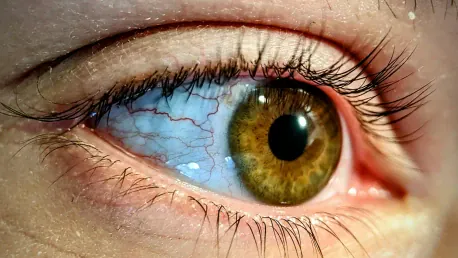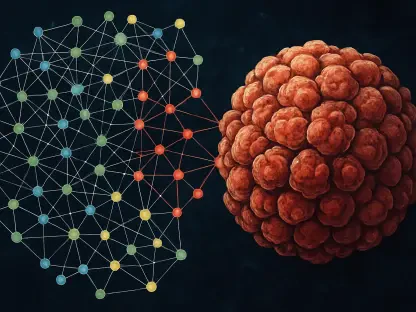Retinitis pigmentosa, an inherited retinal disease, is characterized by progressive vision loss over time, ultimately leading to severe visual impairment. The disease affects the retinal photoreceptor cells, where the degeneration results in the gradual loss of night vision, peripheral vision, and eventually central vision. Currently available treatments provide limited relief, and for many patients, there is an urgent need for innovative and effective solutions to manage this debilitating condition.
Groundbreaking Research on Eye Drops
National Institutes of Health (NIH) researchers have made significant strides in developing eye drops aimed at treating inherited retinal diseases, particularly retinitis pigmentosa. With a focus on utilizing a peptide derived from pigment epithelium-derived factor (PEDF), a naturally occurring protein in the eye, they have embarked on pioneering research to address the challenges posed by this condition. Unlike the full PEDF protein, which is too large to effectively penetrate outer eye tissues and reach the retina, the team has developed smaller peptides that can overcome these barriers, making it feasible for targeted delivery.
The research team, led by Patricia Becerra, Ph.D., recognized the inherent challenge of the full PEDF protein’s size. To overcome this, they created short peptides derived from PEDF that could penetrate the outer eye tissues and bind to PEDF receptor proteins on the retinal surface, thereby promoting cell viability under stress. These peptides, namely “17-mer” and #05A, offer a promising solution to the limitations of current treatments for retinitis pigmentosa.
The Mechanism of PEDF-Derived Peptides
Central to the NIH researchers’ efforts are the two specific peptide formulations: “17-mer,” which contains 17 amino acids from the active region of PEDF, and #05A, a similar peptide with a stronger binding affinity to PEDF receptors. These peptides were designed to interact with PEDF receptor proteins on the retinal surface, fostering cell health and enhancing retinal function. The innovative approach of targeting these receptors ensures that the therapeutic effects are maximized while minimizing potential adverse effects. By binding to PEDF receptor proteins, the peptides can support cell viability and mitigate the stress that leads to degeneration.
This mechanism was tested in mouse models that mimicked the condition of retinitis pigmentosa in humans. These mouse models undergo rapid photoreceptor loss shortly after birth, leading to significant vision impairment within a week. When treated with the peptide formulations, these mice exhibited remarkable retention of photoreceptors and maintained healthier retinas. Notably, the treated mice retained up to 75% of their photoreceptors, and their retinal responses to light were significantly better post-treatment, demonstrating the potential efficacy of the peptides.
Efficacy and Safety Studies
In assessing the effectiveness and safety of the peptide-based eye drops, NIH researchers conducted extensive studies. The treated mice showed substantial retention of photoreceptor cells and demonstrated healthier retinal responses, a stark contrast to the placebo group, which experienced rapid degeneration. These results underscore the potential for PEDF-derived peptides to provide a significant therapeutic effect, slowing the progression of vision loss associated with retinitis pigmentosa.
Moreover, the safety profile of these eye drops was rigorously tested. Not only did the treated animals retain the majority of their photoreceptors, but they also exhibited no signs of toxicity or adverse side effects. This favorable safety profile is a critical factor in the pursuit of human trials, as it implies that these treatments could be administered without risk of harmful reactions. The early success in animal models highlights the promise these peptides hold for future clinical applications.
Advancing the Combination Therapies
In addition to the standalone efficacy of peptide treatments, researchers explored the potential synergy between these treatments and gene therapy. Collaborating with Italian scientists Valeria Marigo, Ph.D., and Andrea Bighinati, Ph.D., the NIH team investigated whether preserving photoreceptors with peptide eye drops could enhance the effectiveness of subsequent gene therapy. This combined approach aims to strengthen vision preservation and extend the duration of therapeutic benefits.
The combination therapy yielded promising results, indicating that photoreceptors maintained by peptide treatments remained viable for gene therapy. This synergy could prolong vision preservation for extended periods, offering a multi-faceted approach to managing retinitis pigmentosa. The potential to integrate peptide and gene therapies represents a significant advancement in developing sustainable and comprehensive treatment protocols for retinal degenerative conditions.
Preparing for Human Trials
To validate these findings further and ensure translational potential, researchers collaborated with Natalia Vergara, Ph.D., at the University of Colorado Anschutz to test the peptides on human retinal tissue models. These models, grown from human cells, underwent chemically induced stress to mimic the degeneration seen in retinal diseases. The peptide treatments yielded encouraging results, preserving the integrity of the retinal tissues.
These promising outcomes mark a critical step toward initiating human clinical trials, an essential phase for evaluating real-world efficacy and safety. Human trials will allow researchers to confirm the therapeutic benefits and safety of PEDF-derived peptides in patients with retinitis pigmentosa, potentially leading to widespread clinical adoption.
Prospects and Future Directions
Retinitis pigmentosa is an inherited retinal disorder marked by a gradual decline in vision, culminating in significant visual impairment. The degeneration starts by affecting the retinal photoreceptor cells, leading to a progressive loss of night vision, peripheral vision, and eventually central vision. As the disease progresses, those affected experience increasing difficulty seeing in low-light conditions, navigating without bumping into objects, and later, reading or recognizing faces as central vision diminishes. Present treatments offer only limited relief and are unable to completely halt or reverse these effects. There’s a pressing need for groundbreaking and powerful treatments to better manage this debilitating condition. The current challenge for researchers and healthcare providers is to develop advanced therapies to slow down the progression, restore some aspect of vision, or repair the damaged retinal cells, ultimately improving the quality of life for individuals living with retinitis pigmentosa.









